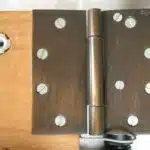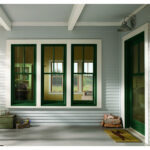Screen doors are an essential part of many homes, providing a barrier against insects and other unwanted guests while allowing fresh air to circulate. While store-bought screen doors can be expensive and may not fit the unique dimensions of your entryway, building a simple screen door yourself is an affordable and satisfying DIY project. With a few basic tools and materials, anyone can create a durable and functional screen door that will enhance the comfort and convenience of their home.
In this article, we will guide you through the process of building a simple screen door from scratch. We will cover all the necessary steps, from measuring and cutting the wood to installing the screening material. By following our instructions carefully and taking your time with each step, you can create a high-quality screen door that will serve your family for years to come. Whether you are an experienced woodworker or have never picked up a saw before, our guide is designed to help you succeed in this rewarding project.
Tools And Materials Needed
Like a painter without a brush, a carpenter without his tools is powerless. Before beginning the construction of your screen door, you’ll need to gather the necessary materials and tools. For this project, you will need a measuring tape, saw, drill with bits, sandpaper or sanding block, hammer or rubber mallet, screwdriver (preferably electric), and safety goggles. It’s also important to choose the right screws for the job; deck screws are ideal for their durability and rust-resistant properties.
When it comes to selecting the screen material for your door, there are various options available. Fiberglass screens are cost-effective and have excellent visibility while keeping out insects. Aluminum screens offer greater strength but can be more challenging to install due to their rigidity. Pet-proof screens are an option if you have pets that may scratch or damage the screen.
Once you’ve gathered your materials and tools and chosen your screen material, it’s time to determine the dimensions of your door. This step is crucial in ensuring that your screen door fits perfectly into its designated space.
Determining Door Dimensions
- Measuring the door opening is the first step to determining the appropriate dimensions for a screen door.
- Careful measurements of the door frame are needed to ensure the right size of door.
- Calculating the door size requires knowledge of the width, height, and depth of the door opening.
- With these measurements taken, the calculations can then be made to determine the ideal size of the door, and the necessary pieces of lumber can be cut.
Measuring The Door Opening
Accurately measuring the door opening is crucial when determining the dimensions for a screen door. As a screen door construction expert, I have witnessed common mistakes made during this process which can lead to ill-fitting doors and wasted materials. It is essential to measure the width and height of the opening at multiple points to ensure accuracy.
One common mistake is assuming that the door opening is perfectly square. This assumption can lead to inaccurate measurements resulting in a door that doesn’t fit properly. To avoid this mistake, measure both diagonals of the opening and compare them. If they are within 1/4 inch of each other, then the opening is square.
Another mistake that occurs during measuring is not accounting for trim or molding around the doorframe. Failing to include these measurements can result in a screen door that doesn’t fit flush against the frame. Ensure to measure from edge-to-edge including any trim or molding in your calculations.
In summary, taking accurate measurements of the door opening is crucial when building a screen door. Avoiding common mistakes such as assuming perfect squareness and forgetting to account for trim or molding will save time, money, and frustration down the road. Remember to take multiple measurements at various points along with both diagonals to achieve precise results.
Calculating The Door Size
Determining the correct size for a screen door requires careful measurements and calculations. While standard sizes are available, not all door openings will conform to these dimensions. As a screen door construction expert, I have encountered situations where custom sizes were necessary to ensure a proper fit.
To calculate the size of a screen door, accurate measuring techniques must be employed. Measuring the width and height of the opening is essential, but it is also important to consider other factors such as clearance requirements and hardware placement. When taking measurements, it is best to measure at multiple points along both the width and height of the opening to ensure accuracy.
Once measurements have been taken, calculations can be made to determine the exact size needed for a screen door. Taking into account any necessary adjustments for clearance or hardware placement will help ensure that the finished product fits perfectly. With proper measuring techniques and careful calculations, a custom-sized screen door can be constructed that will provide both functionality and aesthetic appeal.
Choosing Wood For Your Door
When it comes to choosing the right wood for your screen door, there are several factors to consider. First and foremost, you want a wood that is durable and will withstand the elements. Avoid softwoods such as pine or fir, as they are prone to warping and rotting over time. Instead, opt for hardwoods like oak, maple, or cherry. These woods have a tighter grain structure and are more resistant to moisture.
Another important factor to consider when choosing wood for your screen door is its appearance. You want a wood that looks good and complements the aesthetic of your home. Oak is a popular choice due to its natural beauty and rich color. Cherry also has a warm, reddish hue that can add warmth and character to your entryway.
Once you have chosen your wood, it’s time to think about staining it. Before staining, be sure to sand the surface of the wood thoroughly so that the stain adheres evenly. Apply the stain in thin coats with a brush or rag, allowing each coat to dry completely before applying the next one. For best results, use a high-quality stain that is specifically formulated for outdoor use.
As you move on to cutting and measuring your wood for your screen door project, keep in mind that accuracy is key. Take precise measurements and use a saw with sharp blades to ensure clean cuts. With the right materials and techniques, building a simple screen door can be an enjoyable DIY project that adds both function and style to your home’s exterior.
Cutting And Measuring Wood
Once you have chosen the wood for your screen door, it is time to move onto measuring and cutting. While it may seem like a simple process, it is important to ensure accuracy in order to achieve a functional and aesthetically pleasing end result. Measuring accuracy will ensure that the door fits properly within the frame, while cutting techniques will determine the overall appearance of the door.
Before making any cuts, it is crucial to measure your wood accurately. This involves using a tape measure or ruler and marking out the necessary dimensions on your wood. It is recommended to double-check your measurements before making any cuts to avoid mistakes. Additionally, consider using a square tool to ensure that all angles are precise.
When cutting your wood, there are several techniques that you can use depending on the tools available and personal preference. A circular saw can be used for long cuts, while a jigsaw or handsaw may be preferred for more intricate designs. It is important to take your time and make slow, deliberate cuts in order to avoid splintering or damaging the wood.
- Use clamps or weights to hold down the wood securely during cutting
- Consider wearing safety gear such as goggles and gloves
- Take breaks if necessary in order to maintain focus and prevent mistakes
With accurate measurements and careful cutting techniques, you can now move onto assembling the door frame.
Assembling The Door Frame
Assembling the Door Frame is a crucial step in building a simple screen door. Before you begin, make sure that all of your materials are cut to the correct size. Use precise cutting techniques to ensure that each piece fits together seamlessly. Any mistakes in cutting can result in an ill-fitting frame which will ultimately compromise the effectiveness of your screen door.
When it comes to choosing materials for your door frame, there are several alternatives to traditional wood. PVC or aluminum frames offer a modern look and increased durability against weathering and insects. However, if you prefer the classic look of a wooden frame, be sure to use treated lumber that has been pressure-treated to prevent rot and decay.
Once you’ve chosen your material and cut it to size, assemble the pieces into a rectangular frame using corner brackets. For added stability, consider adding diagonal braces at each corner. These braces will prevent warping or twisting over time and ensure that your door remains functional for years to come. In the next section, we’ll explore how you can add cross braces for even more stability and durability.
Adding Cross Braces For Stability
- Accurate measurements are essential when adding cross braces to a screen door frame in order to ensure stability.
- Cross braces should be cut from wood pieces of appropriate length and width.
- Installation of the cross braces requires bolts, nuts, and washers, as well as a drill and screwdriver.
- The door frame should be leveled before installing the cross braces.
- The measuring tape, square, and pliers should be used to ensure that the cross braces are installed in the correct position.
- Once the cross braces are properly installed, the door should be stable.
Measuring
To ensure stability, adding cross braces is an essential step when building a screen door. However, before you begin the installation process, you must first measure accurately to guarantee that the final product fits perfectly. Measuring tips are critical in this phase of construction.
When measuring for cross braces, it’s easy to make mistakes that can cause issues during installation. One common mistake is measuring only one side of the frame instead of both sides. This can result in an uneven door that won’t open or close correctly. Another mistake is forgetting to take into account the thickness of the cross brace itself when cutting the wood.
To avoid these common errors, it’s best to use a measuring tape and measure both sides of the frame carefully. It’s also crucial to factor in the thickness of the cross brace material when cutting your wood pieces. Taking these precautions will help ensure that your screen door has perfect dimensions and is stable enough to withstand daily use from serving others in your home or business.
Cutting
When it comes to adding cross braces for stability in screen door construction, measuring accurately is only the first step. The next crucial phase is cutting the wood pieces to ensure that they fit perfectly. Choosing the right saw is just as important as accurate measurements since using the wrong saw could result in a crooked or uneven cross brace that won’t serve its purpose.
To make sure that your cross braces are cut correctly, you must choose the right saw for your project. A circular saw or a miter saw can work well depending on the project’s complexity and personal preference. A circular saw is ideal for straight cuts while a miter saw can make angled cuts with greater precision. Whichever saw you choose, it’s essential to use a sharp blade that will not damage or splinter the wood.
Once you have chosen your saw, it’s time to start cutting your wood pieces carefully. Always take into account the thickness of the cross brace material and double-check your measurements before making any cuts. It’s best to cut slightly larger than necessary and then trim down to ensure an exact fit. With patience and attention to detail, you can cut your cross braces precisely, ensuring that your screen door has perfect dimensions and maximum stability when serving others in your home or business.
Installing
Now that we have discussed the importance of measuring and cutting cross braces for screen door construction, the next crucial step is installing them. Proper installation of cross braces ensures that your screen door has maximum stability, preventing it from sagging or warping over time. Plus, a sturdy screen door provides numerous benefits, such as increased ventilation while keeping insects out.
To start with the installation process, you will need to mark where the cross brace will go on both sides of the screen door frame. Place one end of the brace against the side of the frame and secure it in place using screws. Then, position the other end where it needs to go, making sure it’s level before attaching it securely to the opposite side of the frame.
When installing a diagonal cross brace, you will need to make sure that it’s at a 45-degree angle. Secure one end into place on one side of the frame and then position it diagonally across towards the opposite corner. Once you have found its correct position, attach it securely using screws. With these screen door installation tips in mind and proper execution, your screen door will be stable and ready to serve those who come in and out of your home or business for years to come.
Sanding And Finishing The Wood
To ensure the stability and durability of your screen door, adding cross braces is an important step. These braces will help prevent the wood from warping or twisting over time, giving your door a longer lifespan. When installing the braces, make sure they are evenly spaced and flush with the edges of the frame. Use wood glue and screws to secure them in place.
Once you have added the cross braces, it’s time to move on to sanding and finishing your screen door. This step is crucial for both aesthetics and protection against weather damage. Start by sanding all surfaces of the door with a fine-grit sandpaper until they are smooth to the touch. Then, choose a staining technique that fits your desired look and apply it evenly across all surfaces. Allow ample drying time before applying a protective finish such as polyurethane.
Choosing hardware options for your screen door is also an important consideration. Depending on the style of your home and personal preferences, there are various types of handles, hinges, and latches available to choose from. Make sure to select hardware that is both functional and visually appealing. Once you have chosen your hardware, you can move on to installing the screen material by stretching it tightly across the frame and securing it in place with spline or staples.
Installing The Screen Material
The screen material is an essential component of any screen door. It serves as a protective barrier against insects and other unwanted elements, while also allowing fresh air to circulate freely. Choosing the right screen material type is crucial in ensuring that the screen door functions properly and lasts for a long time. The available options include fiberglass, aluminum, copper, and stainless steel. Each has its own set of advantages and disadvantages that must be considered.
Before installing the screen material, it’s important to check if there are any damages or signs of wear on the frame. If there are any issues with the frame, it’s best to address them first before proceeding with the installation. When replacing old screens with new ones, take note of any special instructions or tips for removal and disposal of the old screens to ensure proper waste management practices.
To install the new screen material, start by cutting it to size using sharp scissors or a utility knife. Make sure that there is enough excess material at each edge to overlap onto the frame for secure attachment. After cutting out the screen material, lay it flat over the frame and use a roller tool to press it into place. Securely attach all edges using staples or screws depending on your preference. Finally, trim off any excess material using a utility knife or scissors.
Next up: Attaching Hinges and Hardware
Attaching Hinges And Hardware
Now that the screen door frame is complete, it’s time to attach the hinges and hardware. There are various types of hinges available in the market, such as barrel hinges, piano hinges, and strap hinges. To choose the right type of hinge for your screen door, you need to consider factors such as weight, size, and durability. For instance, if you have a heavy wooden screen door, then barrel hinges would be an ideal choice as they can handle more weight.
Once you have selected the appropriate hinge type for your screen door, it’s time to choose hardware finishes. The hardware finish should match with the color and style of your screen door. Common finishes include brass, chrome, nickel, antique bronze, black matte finish and oil-rubbed bronze. It’s important to select a durable finish that can withstand weather elements such as rain or sunlight.
In summary, attaching hinges and hardware is a crucial step in building a screen door. Choosing the right hinge type based on weight and durability needs consideration while selecting hardware finishes that match with color and style is also important. In the next section, we will discuss how to hang the screen door onto its frame.
Hanging The Screen Door
Accurate measurements of the door frame are essential for a successful hanging of the screen door. Appropriate hinges and fasteners should be chosen according to the weight and material of the door. Installation of the door should be done with caution to ensure proper alignment and sturdiness. Finishing touches such as weatherstripping and decorative touches should be included for a more pleasing aesthetic.
Measuring The Door Frame
The first and most important step in hanging a screen door is measuring the door frame. This can be a tricky process, but it is essential for ensuring that your screen door fits properly and functions as intended. Taking accurate measurements will also save you time and money in the long run, as it will prevent common mistakes such as buying the wrong size screen door or having to make costly adjustments later on.
To measure your door frame, start by measuring the height and width of the opening itself. Be sure to measure both the inside of the frame and the outside, as these dimensions can vary slightly. You should also take note of any irregularities in the shape of the opening, such as arches or sloping sides. Finally, consider any alternative materials that may be necessary based on your specific situation. For example, if your door frame is made of an unusual material like stone or brick, you may need specialized tools or hardware to properly hang your screen door.
It’s important to remember that taking accurate measurements is crucial for a successful DIY project. By avoiding common mistakes and using alternative materials when necessary, you’ll be able to create a custom screen door that fits perfectly and enhances your home’s curb appeal. With these tips in mind, you’ll be well on your way to building a simple yet functional screen door that will serve you and your family for years to come.
Hanging The Door
Hanging the screen door is the next crucial step after measuring your door frame. Proper installation requires choosing the right hardware and adjusting tension to ensure that your screen door opens and closes smoothly. Selecting the appropriate hardware is important as it will support the weight of the door and prevent it from hanging improperly. You should choose hinges, a latch, and a handle that are durable, rust-resistant, and designed for use with a screen door.
Before installing any hardware, you must adjust tension on your screen door. This involves attaching springs or other devices to control how fast or slow your screen door closes. Adjusting tension ensures that your screen door doesn’t slam shut or remain open unintentionally. It also helps to keep bugs out while allowing fresh air to circulate throughout your home. It’s essential to follow manufacturer instructions when adjusting tension on your screen door to avoid damaging the hardware or compromising its functionality.
In conclusion, hanging a screen door requires more than just measuring your doorway and buying a kit; it also involves selecting appropriate hardware and adjusting tension properly. By following these guidelines, you’ll be able to create an aesthetically pleasing yet functional doorway that enhances airflow in your home while keeping unwanted insects at bay. With proper installation techniques, you can enjoy all the benefits of having a screen door without any hassle or frustration!
Adjusting For Proper Fit
According to a recent survey, improper fit is one of the most common issues homeowners face with screen doors. Not only does it compromise the door’s effectiveness, but it also reduces its lifespan. To avoid this problem, proper measuring is crucial before constructing your screen door.
To ensure your screen door fits perfectly, accurately measure the dimensions of your doorway. Measure the height and width of the opening to determine the appropriate size for your screen door. Keep in mind that screen doors should be slightly smaller than regular doors to allow for proper clearance. Once you have recorded these measurements, adjust them according to the type of frame you will use.
Door frame adjustments are necessary when building a screen door because different types require different adjustments. For example, if you are using a wooden frame, you may need to add a quarter-inch to your measurements for an easy fit, while metal frames require more precise adjustments due to their rigidity. Properly adjusting your door frame ensures that your screen door will fit snugly and securely into place.
In summary, proper measuring and door frame adjustments are essential for achieving a perfect fit for your screen door. Taking these steps will not only improve its effectiveness but also extend its lifespan by preventing damage caused by frequent use or harsh weather conditions. Next up: adding a latch or lock to complete the assembly of your DIY screen door project without compromising safety or security measures.
Adding A Latch Or Lock
When it comes to screen door latches or locks, there are several types to choose from. Some popular options include the simple hook and eye latch, slide bolt lock, and keyed deadbolt lock. The hook and eye latch is a basic option that is easy to install and use. It consists of a small hook that latches onto an eye screw attached to the door frame. The slide bolt lock provides more security than the hook and eye latch. It is a simple mechanism that slides into place when you want to secure your screen door. Finally, the keyed deadbolt lock provides the highest level of security for your screen door. This type of lock requires a key to unlock it, making it difficult for intruders to enter your home.
When choosing a latch or lock for your screen door, it’s important to consider security considerations. For instance, if you live in an area with high crime rates or have experienced break-ins in the past, you may want to opt for a more secure option like the keyed deadbolt lock. Additionally, consider any children or pets that may be using the screen door and ensure that the latch or lock is easy enough for them to operate.
Overall, adding a latch or lock to your screen door provides added security and peace of mind. With so many options available on the market today, it’s easy to find one that fits your needs and budget. Just be sure to take into account any relevant security considerations before making your final decision.
Moving forward, it’s important to maintain your newly installed latch or lock properly. In order for it to work effectively over time, regular cleaning and lubrication may be necessary. In addition, be sure not to overload the latch or lock with too much weight as this can cause damage over time. By following these maintenance and care tips, you can ensure that your screen door remains secure for years to come.
Maintenance And Care Tips
As a screen door construction expert, I must say that there’s nothing more satisfying than building something with your own hands. And hey, you did it! Congratulations on your new screen door! But wait… don’t think that the job is over just yet. To ensure screen door durability, it’s important to take care of it properly. Here are some maintenance and care tips to keep your screen door looking and functioning its best.
Firstly, let’s talk about insect prevention strategies. You built this screen door to keep those pesky bugs out, right? Well, they’re still going to try their hardest to sneak in through any little gap they can find. To combat this, make sure your screen is tight and secure in its frame. Check for any tears or holes regularly and patch them up as soon as possible. Also, consider installing weatherstripping around the edges of the door to eliminate any potential entry points.
Another important factor in maintaining your screen door is cleaning it regularly. Dirt and debris can build up quickly, especially if you live in a dusty area or have pets that love to scratch at the screen. Use a soft-bristled brush or vacuum attachment to remove any loose dirt or cobwebs from the mesh. For tougher stains or grime buildup, use a gentle soap solution and rinse thoroughly with water afterwards.
Now that you know how to maintain your new screen door properly, you’ll be able to enjoy its benefits for years to come! But what if something goes wrong? Don’t worry – in our next section we’ll go over some troubleshooting common issues so you can handle anything that comes your way.
Troubleshooting Common Issues
To ensure that your screen door lasts for a long time, it is important to properly maintain and care for it. Regular cleaning with a soft cloth and mild soap can help prevent dirt and grime buildup. Avoid using harsh chemicals or abrasive materials that can damage the screen or frame.
Another thing to keep in mind is to check for common issues such as loose screws, warped frames, or torn screens. These can be easily fixed by tightening screws, straightening out the frame, or replacing the damaged screen. By addressing these issues early on, you can prevent further damage and save yourself time and money in the long run.
Prevention techniques are also key in ensuring your screen door remains in good condition. For example, installing a door closer can help prevent slamming which can cause damage to the frame or screen. Additionally, placing rubber stoppers on the bottom of the frame can help protect against scratches caused by opening and closing the door.
- Use weather-resistant materials for outdoor use.
- Consider adding decorative elements like trim or paint.
- Opt for a pet-friendly design with reinforced screens.
- Add a security feature such as a locking mechanism.
- Install a retractable screen option for added versatility.
With these common solutions and prevention techniques in mind, you can keep your screen door looking great and functioning properly for years to come. But if you’re looking to take things up a notch, why not customize your design? In the next section we’ll explore various ways you can personalize your screen door to suit your style preferences and needs.
Customizing Your Design
Like a painter with a blank canvas, designing your own screen door can be a rewarding experience. The possibilities for inspiration are endless; from nature to architecture, there is always something that can spark your creative spirit. Take the time to research different styles and designs that suit your taste and personality. This will ensure that the end result reflects your unique style.
When it comes to customization, color options are an important consideration. A well-chosen color can add warmth and vibrancy to a space, while also complementing existing fixtures or furniture. Neutral colors such as beige or gray are popular choices for their versatility, while bolder colors like red or blue can make a bold statement. Don’t be afraid to experiment with different hues and shades until you find the one that suits your vision best.
At the end of the day, designing and customizing your own screen door is all about personal preference. Whether you choose to keep it simple or add intricate details, the most important thing is that it fits your needs and style. So take inspiration from design trends or create something entirely new – the possibilities are endless!
Conclusion
Building a simple screen door may seem like a daunting task, but with the right tools and materials, it can be accomplished in just a few easy steps. To begin, determine the dimensions of your door and choose the appropriate wood for your project. Cut and measure the wood pieces carefully before assembling the frame and adding a latch or lock.
Regular maintenance is key to ensuring your screen door lasts for years to come. Common issues such as sagging or sticking can be easily fixed with proper care. By customizing your design, you can create a unique screen door that complements your home’s style.
According to recent statistics on home improvement projects, DIY renovations have increased by 26% since 2020. With more people spending time at home due to the pandemic, many are taking on projects such as building their own screen doors. As an expert in screen door construction, I encourage homeowners to take on these DIY projects with confidence and enjoy the satisfaction of creating something functional and beautiful for their homes.
Image Credits
- “Jennifer – Water drop” by distar97 (featured)





























